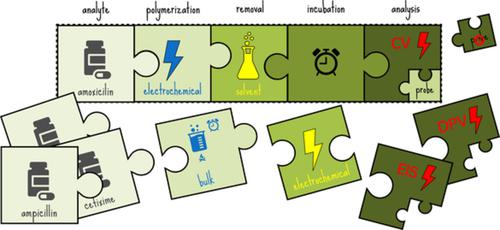当前位置:
X-MOL 学术
›
J. Mol. Recognit.
›
论文详情
Our official English website, www.x-mol.net, welcomes your
feedback! (Note: you will need to create a separate account there.)
Employing molecularly imprinted polymers in the development of electroanalytical methodologies for antibiotic determination
Journal of Molecular Recognition ( IF 2.3 ) Pub Date : 2020-10-06 , DOI: 10.1002/jmr.2878 Ingrid Benachio 1 , Alnilan Lobato 1 , Luís Moreira Gonçalves 1
Journal of Molecular Recognition ( IF 2.3 ) Pub Date : 2020-10-06 , DOI: 10.1002/jmr.2878 Ingrid Benachio 1 , Alnilan Lobato 1 , Luís Moreira Gonçalves 1
Affiliation

|
Antibiotics, although being amazing compounds, need to be monitored in the environment and foodstuff. This is primarily to prevent the development of antibiotic resistance that may make them ineffective. Unsurprisingly, advances in analyticalsciences that can improve their determination are appreciated. Electrochemical techniques are known for their simplicity, sensitivity, portability and low‐cost; however, they are often not selective enough without recurring to a discriminating element like an antibody. Molecular imprinting technology aims to create artificial tissues mimicking antibodies named molecularly imprinted polymers (MIPs), these retain the advantages of selectivity but without the typical disadvantages of biological material, like limited shelf‐life and high cost. This manuscript aims to review all analytical methodologies for antibiotics, using MIPs, where the detection technique is electrochemical, like differential pulse voltammetry (DPV), square‐wave voltammetry (SWV) or electrochemical impedance spectroscopy (EIS). MIPs developed by electropolymerization (e‐MIPs) were applied in about 60 publications and patents found in the bibliographic search, while MIPs developed by other polymerization techniques, like temperature assisted (“bulk”) or photopolymerization, were limited to around 40. Published works covered the electroanalysis of a wide range of different antibiotics (β‐lactams, tetracyclines, quinolones, macrolides, aminoglycosides, among other), in a wide range of matrices (food, environmental and biological).
中文翻译:

在开发用于抗生素测定的电分析方法中使用分子印迹聚合物
抗生素虽然是令人惊奇的化合物,但需要在环境和食品中进行监测。这主要是为了防止可能使它们无效的抗生素耐药性的发展。不出所料,可以提高他们的决心的分析科学的进步受到赞赏。电化学技术以其简单、灵敏、便携和低成本而著称;然而,如果没有像抗体这样的区分元素,它们通常没有足够的选择性。分子印迹技术旨在创建模拟抗体的人工组织,称为分子印迹聚合物(MIP),这些分子印迹聚合物保留了选择性的优点,但没有生物材料的典型缺点,如保质期有限和成本高。本手稿旨在回顾所有使用 MIP 的抗生素分析方法,其中检测技术是电化学的,如差分脉冲伏安法 (DPV)、方波伏安法 (SWV) 或电化学阻抗谱 (EIS)。通过电聚合 (e-MIP) 开发的 MIP 在书目搜索中发现的大约 60 种出版物和专利中得到应用,而通过其他聚合技术(如温度辅助(“本体”)或光聚合)开发的 MIP 被限制在 40 左右。已发表的作品涵盖了各种基质(食品、环境和生物)中各种不同抗生素(β-内酰胺类、四环素类、喹诺酮类、大环内酯类、氨基糖苷类等)的电分析。如差分脉冲伏安法 (DPV)、方波伏安法 (SWV) 或电化学阻抗谱 (EIS)。通过电聚合 (e-MIP) 开发的 MIP 在书目搜索中发现的大约 60 种出版物和专利中得到应用,而通过其他聚合技术(如温度辅助(“本体”)或光聚合)开发的 MIP 被限制在 40 左右。已发表的作品涵盖了各种基质(食品、环境和生物)中各种不同抗生素(β-内酰胺类、四环素类、喹诺酮类、大环内酯类、氨基糖苷类等)的电分析。如差分脉冲伏安法 (DPV)、方波伏安法 (SWV) 或电化学阻抗谱 (EIS)。通过电聚合 (e-MIP) 开发的 MIP 在书目搜索中发现的大约 60 种出版物和专利中得到应用,而通过其他聚合技术(如温度辅助(“本体”)或光聚合)开发的 MIP 被限制在 40 左右。已发表的作品涵盖了各种基质(食品、环境和生物)中各种不同抗生素(β-内酰胺类、四环素类、喹诺酮类、大环内酯类、氨基糖苷类等)的电分析。
更新日期:2020-10-06
中文翻译:

在开发用于抗生素测定的电分析方法中使用分子印迹聚合物
抗生素虽然是令人惊奇的化合物,但需要在环境和食品中进行监测。这主要是为了防止可能使它们无效的抗生素耐药性的发展。不出所料,可以提高他们的决心的分析科学的进步受到赞赏。电化学技术以其简单、灵敏、便携和低成本而著称;然而,如果没有像抗体这样的区分元素,它们通常没有足够的选择性。分子印迹技术旨在创建模拟抗体的人工组织,称为分子印迹聚合物(MIP),这些分子印迹聚合物保留了选择性的优点,但没有生物材料的典型缺点,如保质期有限和成本高。本手稿旨在回顾所有使用 MIP 的抗生素分析方法,其中检测技术是电化学的,如差分脉冲伏安法 (DPV)、方波伏安法 (SWV) 或电化学阻抗谱 (EIS)。通过电聚合 (e-MIP) 开发的 MIP 在书目搜索中发现的大约 60 种出版物和专利中得到应用,而通过其他聚合技术(如温度辅助(“本体”)或光聚合)开发的 MIP 被限制在 40 左右。已发表的作品涵盖了各种基质(食品、环境和生物)中各种不同抗生素(β-内酰胺类、四环素类、喹诺酮类、大环内酯类、氨基糖苷类等)的电分析。如差分脉冲伏安法 (DPV)、方波伏安法 (SWV) 或电化学阻抗谱 (EIS)。通过电聚合 (e-MIP) 开发的 MIP 在书目搜索中发现的大约 60 种出版物和专利中得到应用,而通过其他聚合技术(如温度辅助(“本体”)或光聚合)开发的 MIP 被限制在 40 左右。已发表的作品涵盖了各种基质(食品、环境和生物)中各种不同抗生素(β-内酰胺类、四环素类、喹诺酮类、大环内酯类、氨基糖苷类等)的电分析。如差分脉冲伏安法 (DPV)、方波伏安法 (SWV) 或电化学阻抗谱 (EIS)。通过电聚合 (e-MIP) 开发的 MIP 在书目搜索中发现的大约 60 种出版物和专利中得到应用,而通过其他聚合技术(如温度辅助(“本体”)或光聚合)开发的 MIP 被限制在 40 左右。已发表的作品涵盖了各种基质(食品、环境和生物)中各种不同抗生素(β-内酰胺类、四环素类、喹诺酮类、大环内酯类、氨基糖苷类等)的电分析。











































 京公网安备 11010802027423号
京公网安备 11010802027423号